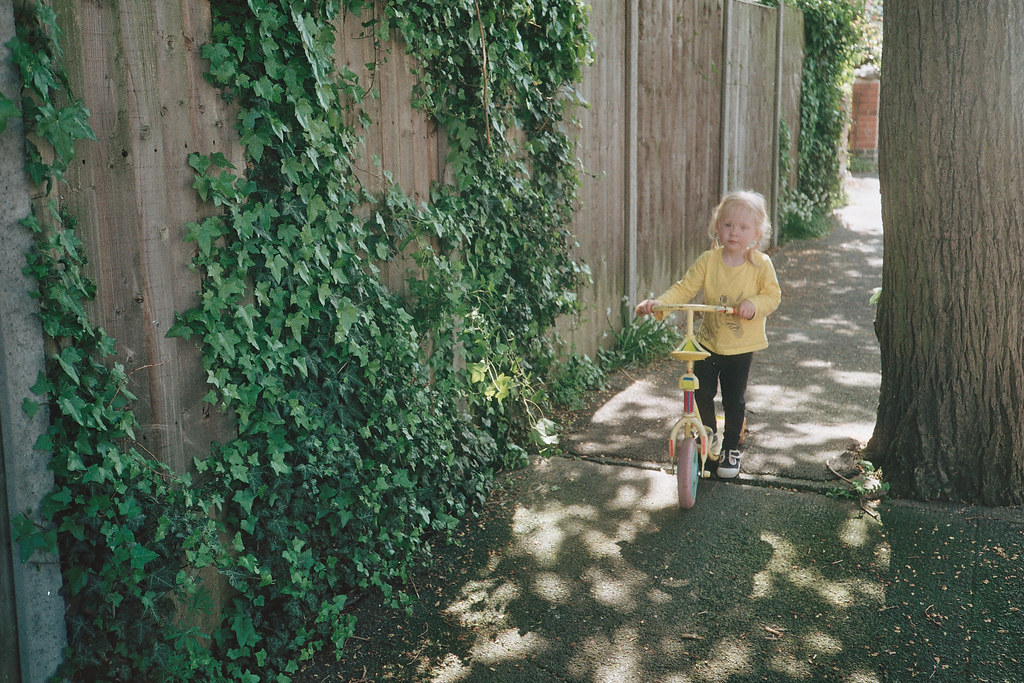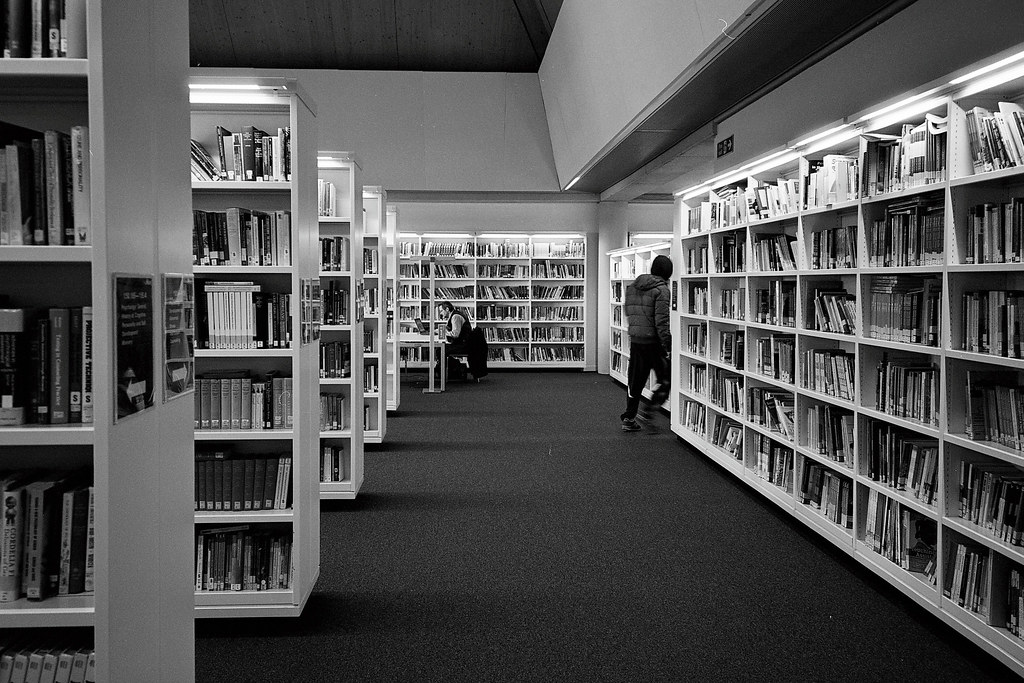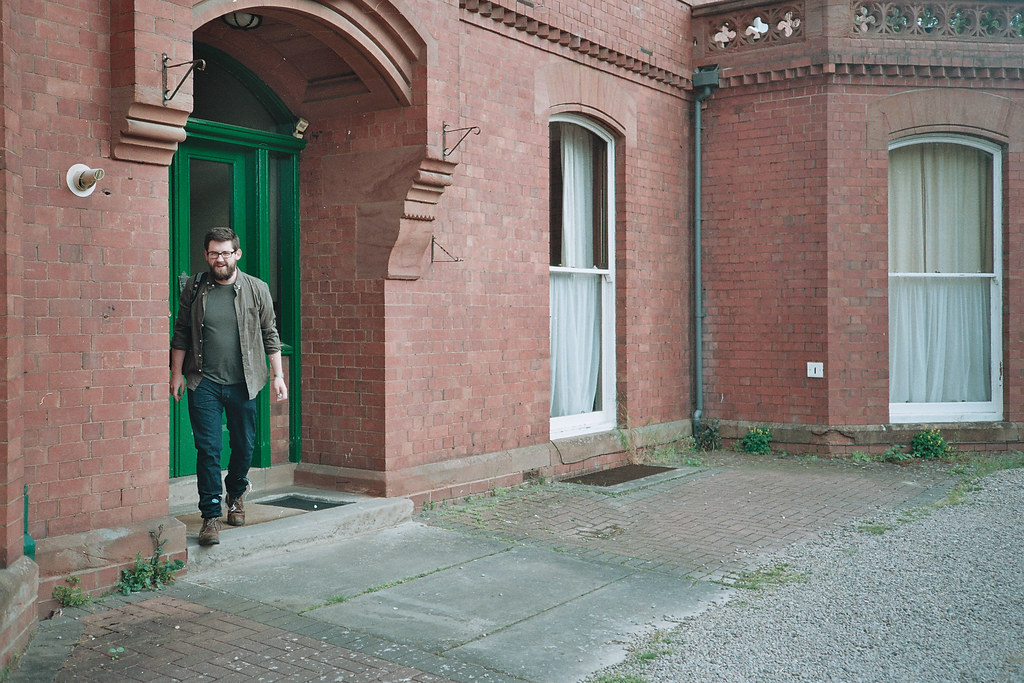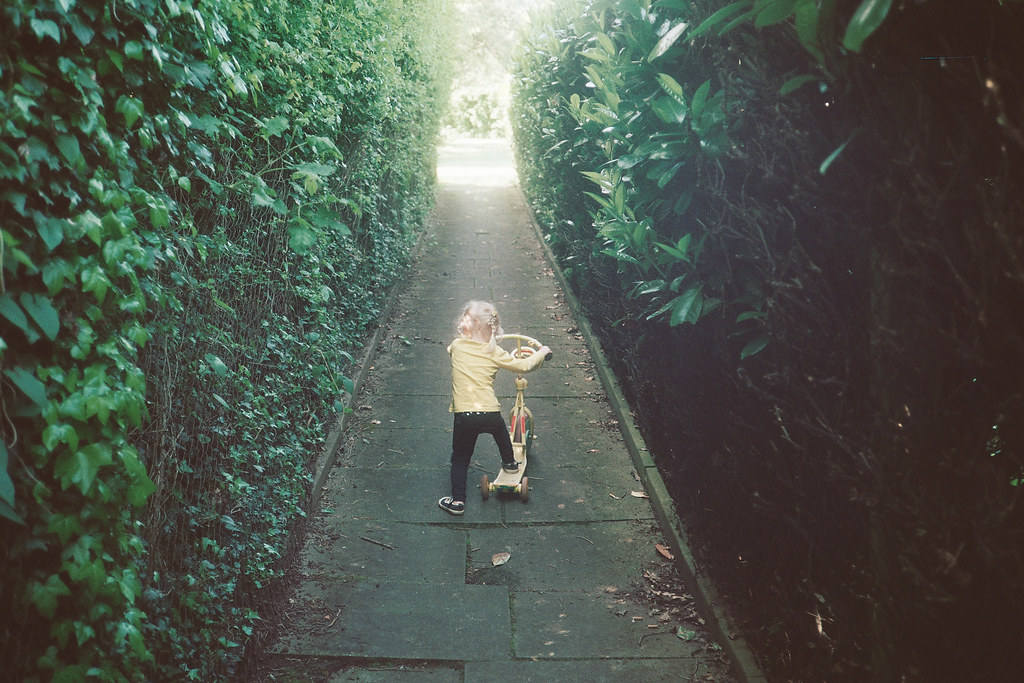The Pentax PC35AF is a camera I have been meaning to review for quite some time now, I’ve just not had the motivation to do so. I’ve had quite a few of its variant models over the years, but I’ve not had a lot of luck with their working condition. I currently own four, though I’ve used two of them to fix the other two. This has left me with one PC35AF and one PC35AF-M, the later of which being a thing of fairly strong sentimental value to me. I’ve decided to do a review of both these models together, they both have their own merits (strong word?), but to my mind, only one of them is of particular interest as a camera I might use in anger.

My PC35AF is mostly made up of a charity shop find, I think it cost me £1. I didn’t notice it was a little ropey until I had got it home, but for a single pound I didn’t care. I’d bought it because I knew the other one I had was definitely broken; I knew this because it was me who definitely broke it. I had dropped it, resulting in the autofocus packing up; I’d not even dropped it far, but it was game over. I’d caused what I guess to be a loose connection inside somewhere as it’d resulted in the AF only working perhaps 1 in 10 times. As you can probably imagine it became very frustrating to use. I used the battery compartment cover, bottom plate and top plate off the one I broke, not to mention a small amount of Araldite, to fix the later charity shop find, which although still at little tatty, does at least function as largely as it should.
The other two PC35AF-M’s, both of which came to me broken, have also recently merged into one functioning camera. Both of these cameras were given to me at some point in the last 10 or so years, the sentimental value comes from who it was that owned them before. The first was my Dad’s, given to me after he died, the second was given to me much more recently by my biological father. A funny little coincidence that both adopted and biological fathers would have the same camera entirely independently of each other. Needless to say, getting my Dad’s camera to work using a couple of parts from Graham’s long dead one put a big smile on my face. It is certainly a camera I will be keeping!

Until recently, all these four cameras had lay unused, and actually to my mind were destined to stay that way. This was at least until just the other day when they came to mind as a possible option for some fairly stealthy shooting …
Not so long ago I’d been taking some photos in ‘The Hive’; our local Library. A very interesting looking building, both in and out; some people hate it, I love the place. It’s not exactly conventional, but the shape of it makes for some very interesting photography, as do the people using the space. There is something about spaces like this that I really enjoy shooting, I quite often find myself in them on days out with the family. I have collated a few photos on my website here, The Hive just happens to be the most local place so gets shot more often.
Now clearly, being a library, I don’t want to be using a camera that is anything other than discreet. I find even the M7 to be too conspicuous for shooting with comfort in there (maybe I should have bought a black one?). For the way I like to shoot candidly AF works well – camera to eye, point, and shoot. This is one of the biggest draws to shooting with a 35mm compact camera for me, I don’t feel like a photographer, or at very least, I don’t feel like people will view me as one. I see this as a distinct advantage in these modern times where us photographers are being looked upon with increasing suspicion.
The last time I was in there I took a few shots with the Ricoh GR1v, a fairly quiet camera, but since it has an auto-advance that makes an obvious sound, I felt a little conspicuous. My photography of strangers rarely depicts them closely enough for them to be much more than elements within a larger frame, I do like photographing strangers, but I don’t have the courage, nor indeed the desire to turn them into the sole subject of the photo. Hopefully you can see in my photos what I mean by this. To this end, I hope I’m not invading anyone’s privacy, I suspect some might argue that I am, but I’m comfortable in the feeling that I’m not… The point I’m trying to make is that given a quiet environment, I want to be discreet in my shooting and this is as much to avoid disturbing people as it is to avoid getting “caught”.

In short, I had come to the conclusion that I wanted a 35mm compact camera, I wanted it to have autofocus, but either have a silent film advance, or a manual one. The obvious camera that comes to mind is probably the Konica Hexar AF, which remains on my shopping list, but whilst funds are short, seems to be staying there. Despite having owned and used a PC35AF, this Pentax didn’t immediately spring to mind. I suspect the main reason for this being that they are not especially quiet! Especially the later ‘M’ version.
The primary difference between the earlier PC35AF and the subsequent ‘M’ version is the film advance. ‘M’ stands for Motor, as in motor-drive, ie it has a motor driven automatic film advance, a fairly noisy one at that. It’s also quite large. The original version on the other hand, unless you choose to attach the accessory motor-drive is advanced with a thumb wheel. This not only keeps it quieter, but also smaller. Unfortunately though, its quietness is entirely jeopardised by an irritating warning beep that emanates from it when the light is low enough for it to suggest the use of flash. I suppose it was this that stopped the Pentax from coming to mind… I then stumbled across this post on 6500k that jogged my memory about it. A bit more reading and memory jogging elsewhere, and I was reminded of that damn beeping noise… a dead end; that beeping does not make for a discreet camera! Though what if the beeping could be stopped…? I am going over old ground here a little… cutting to the chase, I disabled the beeping.
So now I am left with a manual film advance, autofocus, fairly inconspicuous 35mm compact camera… But it is actually any good? Well firstly, I expect it is clear which out of the PC35AF and PC35AF-M I prefer. The ‘M’, to my mind holds little real attraction (beyond the sentimental). It comes with all the disadvantages of the earlier model (which I shall get to in a moment) and does away with its few aces by adding bulk and a noisy motor-drive. Admittedly the bulk means it handles better than its elder sibling; the additional plastic and metal allowing a more comfortable grip. And it has film speed setting up to 1000iso over the 400iso limit of the first version. But really, it’s just a fairly clunky first generation autofocus point and shoot.
And this clunkiness is a major part of the issue with these cameras. Yes they have part metal exoskeletons, and quite nice lenses, but they don’t feel smooth or refined in use. The shutter button has a bit too much travel, and the autofocus feels as much like a first attempt as it is; it sort of squeaks into action with the travel of the shutter. There is a distance indicator in the viewfinder that tells you the distance at which the camera is focused. But it’s so flakey that I had for a long time convinced myself even the working versions I have of this camera had faulty autofocus. Though I suppose, whilst it does feel clunky, the reality is that it’s ok. You do have to get a feel for it, but once you do it works to a point. The distance is indicated by the standard zones; head and shoulders, couple of people and mountains for infinity. Keeping an eye on the indicator and trying a couple of times when it doesn’t seem quite right is par for the course. Sometimes it will claim focus wildly out from what you expect, which of course is easily spotted but sometimes it can be out and it not be so obvious. The key is getting to grips with its idea of what the zone distances are. The manual states the first distance, the head and shoulders, to be 0.8m; the second, the couple of people, to be 1.5m and the mountains to be infinity. This means that the first three quarters of the scale in the viewfinder from right to left deal with focusing up to 1.5m and then the last little bit 1.5m to infinity. Of course all focusing scales are exponential, but something about this one doesn’t feel quite intuitive. It’s not particularly easy to explain, and you do get used to it, but it’s worth bearing in mind when you first pick up the camera I think. It is also worth getting your head firmly around what 0.8m and 1.5m actually look like too. I’m pretty good at judging shortish distances in meters, and have found that ability to judge very useful when using this camera. It is especially useful to have an idea what 0.7 meters looks like as this is the closest the camera can focus, and there is no warning or indication when you are too close. I am actually pretty sure it can focus a little closer than 0.7 meters, despite what it says on the front, but as closer focusing is so hit and miss, it’s not worth trying in my books.

So did it solve my problem of wanting to shoot photos in the library without causing any disturbance or drawing attention to myself? Despite its flaws did it find a niche use for me? … Well, I haven’t actually tried in the library yet, but I’m not entirely convinced it does solve the problem in terms of the noise it makes. It’s certainly quieter now it doesn’t beep, but the shutter does make a sound, and a sound that couldn’t exactly be described as discreet. Where is does excel though is that it looks very unassuming. Whilst perhaps a little bigger than I might like, to the average onlooker, it’s not going to look anything special at all. And whilst I didn’t have a chance to shoot in the library I did push myself into some, not-especially-good street shooting…

… And I felt inconspicuous! There really is not much like (what is to the outside world) a crappy looking camera to aid this feeling for me.
A little bit on the Pentax PC35AF lens
There are no end of 35mm 2.8 point & shoot cameras out there, but if you read enough online you will find plenty of folks talking about how nice the lens is. It is certainly capable of producing some very sharp photos.

But given slightly harder to deal with lighting conditions results seem somewhat less conventional.

There is really is something quite nice about the images, they aren’t perfect by any stretch of the imagination, but they do have a lovely character. High contrast areas seem to have a little bit of glow to them, especially at wider apertures. I suppose this is just down to the camera being a little older than the AF p&s cameras I am used to shooting with, one way or another I do like the photos!
A conclusion
Two cameras here. One is too bulky, clunky has crap autofocus and needs modification to not annoy you with it beeping noise. The other builds on these downfalls by including a noisy motor drive and is bigger still. In short, they are not particularly great cameras, especially when held up against many of the other similarly priced cameras on the second hand market! But, and this is a big but for me, something about them is unquestionably endearing! Maybe it’s the design of them … They are, to my mind at least, pretty good looking bits of kit (If you like that sort of thing). Maybe it’s the fact that they just add a little bit of extra challenge to the experience of shooting them? Or maybe it is the simplicity of them that makes shooting them an enjoyably uncomplicated process? Or it might just be as simple as the photos they produce … One way or another, I can’t help but like these cameras, I know deep down that really I could have a much more reliable shooting experience with something a little more modern, or indeed something older and mechanically sound. But if all I wanted from a camera was reliability, I probably wouldn’t even pick up an early 80’s AF compact like these clunky old Pentax PC35AF’s would I?!
Cheers for reading!
Hamish
Share this post:









Comments
Paulo Moreira on Pentax PC35AF Review – A camera with a certain charm
Comment posted: 07/03/2015
charlez on Pentax PC35AF Review – A camera with a certain charm
Comment posted: 09/04/2016
Comment posted: 09/04/2016
The Minolta AFZ - a mini review - 35mmc on Pentax PC35AF Review – A camera with a certain charm
Comment posted: 11/04/2016
Jamie on Pentax PC35AF Review – A camera with a certain charm
Comment posted: 04/12/2016
Daniel VanDurmen on Pentax PC35AF Review – A camera with a certain charm
Comment posted: 16/08/2017
Point and Shoot Shootout on a Budget - By Dan Marinelli - 35mmc on Pentax PC35AF Review – A camera with a certain charm
Comment posted: 19/07/2019
Scott on Pentax PC35AF Review – A camera with a certain charm
Comment posted: 19/08/2019
Comment posted: 19/08/2019
MoriGuild on Pentax PC35AF Review – A camera with a certain charm
Comment posted: 26/03/2020
Comment posted: 26/03/2020
Ashley Carr on Pentax PC35AF Review – A camera with a certain charm
Comment posted: 06/05/2020
Overall I’ve been very impressed by this PC35AF. Smaller than my long gone Nikon L35AF and better than my current Canon Sureshot M (crippled for me by DX coding only).
AF seems to be spot on with my my copy and I’m often left shaking my head in disbelief at the output this camera can deliver, especially with FP4.
Camera Review Blog No. 128 – Pentax PC35AF – Alex Luyckx | Blog on Pentax PC35AF Review – A camera with a certain charm
Comment posted: 01/02/2021
Martino on Pentax PC35AF Review – A camera with a certain charm
Comment posted: 22/06/2022
WATCH: The Pentax PC35AF-M, an undersung cult compact from the 1980s - Kosmo Foto on Pentax PC35AF Review – A camera with a certain charm
Comment posted: 10/10/2022